American "generals" on Russian fields
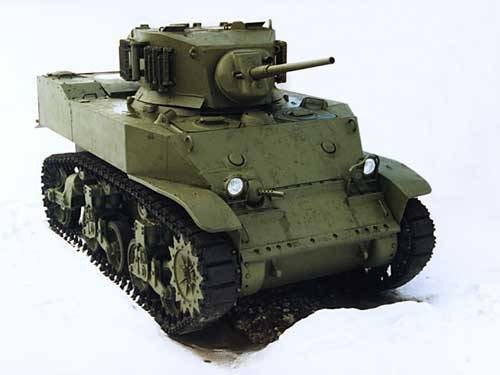
"BROTHER'S GRAVE"
According to his plan, the M3 was a car of the times of the First World War with the location of the gun in the airborne sponson, as on the British tanks Mk I, Mk VIII, only instead of the fixed felling he had a rotating tower. The engine was located in the stern, the transmission was located in front of the hull, the gearbox was located under the turret's pivoting floor.
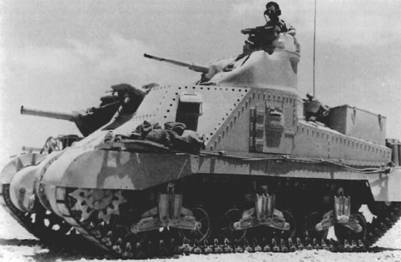
The hull of the tank was made of flat armor plates. Armor thickness remained unchanged on all models: two inches (51 mm) - forehead, one and a half inches (38 mm) - sides and stern, half an inch (12,7 mm) - hull roof. The bottom had a variable thickness - from half an inch (12,7 mm) under the engine to one inch (25,4 mm) in the combat compartment area. Reservation tower: walls - two inches and a quarter (57 mm), the roof - seven eighths of an inch (22 mm). The front plate was set at an angle 600 to the horizon, the side and rear - vertically.
The M3 was equipped with a cast sponson with a 75-mm cannon mounted on the right side of the hull and not going beyond its dimensions. A cast turret with an 37-mm gun shifted to the left above the tank hull, it was crowned with a small turret with a machine gun. The height of this “pyramid” reached 10 feet 3 inches (3214 mm). The length of the M3 is 18 feet 6 inches (5639 mm), the width is 8 feet 11 inches (2718 mm), the ground clearance is seventeen and one eighth inches (435 mm). True, the fighting compartment of the car was spacious and is still considered one of the most comfortable.
Inside, the M3 case was covered with spongy rubber to protect the crew from small fragments of armor. Doors along the sides, hatches on the top and in the machine-gun turret ensured a quick landing of the tank crews. In addition, the former were convenient for evacuating the wounded from the car, although they reduced the strength of the hull. Each crew member could fire from a personal weapons through the viewing gaps and embrasures protected by armor visors.
On modifications MZA1 and MZA2 mounted aviation star-shaped nine-cylinder Wright Continental R 975 EC2 or C1 carburetor engine with a capacity of 340 liters. with. It provided the 27-ton tank with the highest speed of up to 26 mph (42 km / h) and mileage of 120 miles (192 km) with a fuel capacity of 175 gallons (796 liters). The disadvantages of the engine include its high fire hazard, since it worked on high-octane gasoline, and the difficulty in servicing, especially the cylinders that were on the bottom.
The main weapon of the tank was the 75-mm gun M2 in the sponson with almost three-meter barrel. It was designed in the Westerflute arsenal based on the 75-mm French field gun of the 1897 model of the year adopted by the US Army after the First World War. The gun had a one-plane aiming stabilizer, a semi-automatic shutter and a barrel purge system after the shot. By the way, it was precisely at the Ministry of Health that the system of stabilization of aiming in the vertical plane was used for the first time in the world, which later served as a prototype for similar systems in tanks of many armies. The cannon's pointing angles - 140 horizontally - 320, then the cannon was induced by turning the entire tank. The vertical aiming of the gun was carried out both electro-hydraulically and manually. Ammunition was located in the sponsor and on the floor of the car.
However, when installing the M2 gun on the tank, it turned out that the barrel extends beyond the front line of the hull. This greatly alarmed the military, who were afraid that the car could be hooked on something while moving. At their request, the barrel length was reduced to 2,33 m, which naturally worsened the ballistics of the gun. Such a truncated gun was assigned an MH index, and when mounted in a tank, in order not to override the stabilization system, a counterweight was put on the barrel that looked like a muzzle brake.
The 37-mm gun was created in the same Westherflute arsenal in the 1938 year. On the M3 tank, its M5 or M6 modifications were installed in a rotating tower on the 3600. The corners of the vertical pickup allowed to fire on low-flying aircraft. The turret also had a machine gun paired with a gun, and on top was a small turret rotating on the 3600, with another machine gun. The tower had a rotating polik with walls that separate the fighting compartment into a separate compartment. The ammunition of the gun was located in the turret and on the rotating polycom.
The weight of the M3 was 27,2 t, and the number of crew members was 6-7 people.
The medium tanks M3 supplied to the USSR were called "mass graves" by tankmen.
PREFERRED DIRECT AND EQUAL ROADS
The Yankees had the sense to light a Stewart tank to assign the same M3 index as the average tank. Therefore, in Soviet official documents, these tanks were called light (l.) М3 and medium (cf.) М3. It is not difficult to guess how our tank crews deciphered “cf. M3.
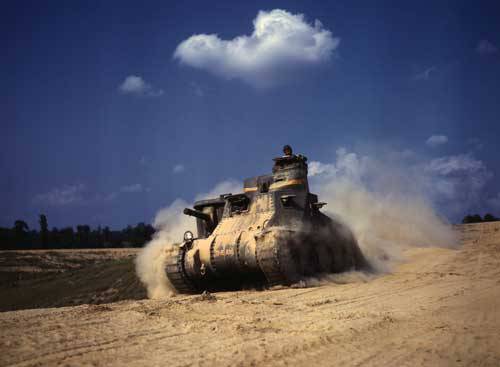
The lighter weight of the M3 was 12,7 T, the thickness of the armor was 37,5-12,5 mm. Ammunition for the 37-mm gun M3 - 103 shot. Crew - 4 person. Speed on the highway - 56 km / h. The cost of a light tank M3 - 42 787 dollars, and the average M3 - 76 200 dollars.
The properties of the American tanks M3 are quite well shown in the report of the GBTU from 1 November 1943 of the year: “On the march, the M3-c and M3-l tanks are hardy and trouble-free. In service are simple. Allow to make marches at higher average speeds of movement in comparison with domestic tanks.
When choosing a route, preferably should be chosen more direct and wide roads. The presence of a large turning radius for tanks M3-c and M3-l, on narrow roads with frequent roundings, causes the danger of the vehicles coming down into roadside ditches and reduces the speed of movement.
With the march in winter conditions tanks have the following disadvantages:
a) low traction of the caterpillar with the ground, which leads to slippage, lateral and direct gliding (with unskillful actions of the driver on the climbs, slopes and rolls, the tank loses control);
b) the spurs of the existing structure do not sufficiently provide the tank against slipping and sliding of the tracks and very quickly fail. It is necessary to change the design of the spur and fasten it to the truck to ensure greater adhesion to the ground and prevent side-slip;
c) when a single caterpillar hits a ditch, a tank funnel, having a double differential system in turn control, due to slippage, the caterpillar that is under light load cannot independently overcome obstacles. A slidable caterpillar that is in an inclined position, as a rule, subsides ...
From the marches in the composition of the regiment revealed:
a) power reserve on a winter rolled road:
for M3-s - 180-190 km,
for M3-l - 150-160 km;
b) the average technical traffic speed on a dirt road in the winter:
for M3-s - 15-20 km,
for M3-l - 20-25 km.
The crew of the M3-s crew is located conveniently, the landing is free. Motor fan provides fresh air and the internal temperature of the tank.
Managing physical tension does not require.
The suspension of the tank ensures smooth running.
Crew fatigue is negligible.
In the M3 tank, the accommodation of the crew is cramped, the management of the tank is difficult, and during the crew’s long work in the tank, its fatigue compared to the M3 is large. Due to the lack of lightening aids, the driver-mechanic, compared with the M3-c, spends a greater effort to control the tank.
The commander of the M3-l tank is almost isolated from the crew - it is located behind the cradle and the management of other means besides TPU (tank intercom. - A. Sh.) Is difficult ...
Maneuverability over marshy ground is poor due to the high specific pressure (especially for the M3-s), which leads to a deep immersion of the caterpillar into the ground, a sharp decrease in speed and difficulty turning.
For the better, the M3-l stands out, having the ability to overcome boggy areas of insignificant length at high speeds.
Movement in the forest with stumps is difficult.
The guns on the M3-s and M3-l are trouble-free in battle. Due to the special device of sights from guns, fire is conducted only by direct fire.
Telescopic gun sights are easy to make and accurate when firing. The commanders of the guns, in comparison with other sights, find targets more easily through them, hold them more steadily in sight and quickly establish the scope.
The negative side of the 75-mm gun of the M3-c tank is a small horizontal firing angle (32 degrees).
The high power of machine gun fire (four Browning machine guns) does not give the desired effect due to the lack of sights on machine guns with the exception of a machine gun paired with an 37-mm cannon. In the frontal machine guns, there is absolutely no possibility of observing the fire, which allows them to be used only after passing through the combat formations of their infantry ...
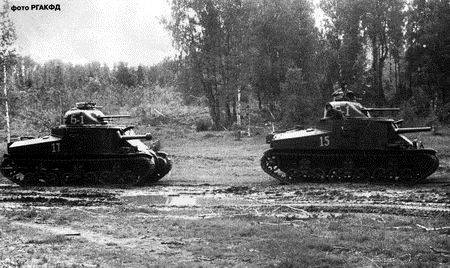
Armor resistance is low. From a distance of 800 m penetrates the entire anti-tank artillery. A heavy machine gun pierces the armor of the M3-l from a distance of 500. The armor of the M3-with a large-caliber machine gun does not break through.
Tanks М3-с and М3-л, working on gasoline engines, have easy flammability. When shells hit the combat or engine compartment from the presence of gasoline vapors inside the tank, there is often a fire. There is a flammability of fuel from detonation. These reasons cause large losses of crew personnel.
The two stationary and two portable fire extinguishers on the tank are effective. With timely use of their fire, as a rule, stops. "
FREQUENTLY TAKEN FOR ENEMY
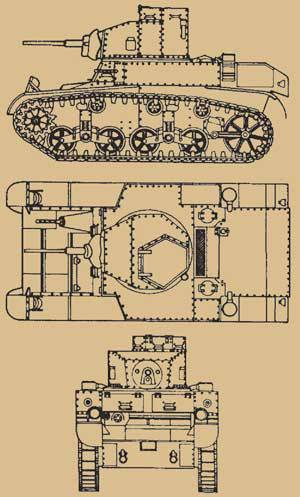 The best and most massive medium tank in the USA was the M4 "Sherman". The tests of an experienced Sherman with an 75-mm cannon in the turret began in September 1941 at the Aberdeen Proving Ground.
The best and most massive medium tank in the USA was the M4 "Sherman". The tests of an experienced Sherman with an 75-mm cannon in the turret began in September 1941 at the Aberdeen Proving Ground.The hull of the M4А2 tank was welded from rolled armored plates. The top front plate 50 mm thick was located at an angle 470. The sides of the body vertical. Tilt angle of stern plates - 10-120. The armor of the sides and the stern had a thickness of 38 mm, the roofs of the hull were 18 mm.
The cast cylindrical tower was installed on a ball bearing. The forehead and sides were defended with 75-mm and 50-mm armor, respectively, feed - 50-mm, the roof of the tower - 25-mm. In front of the tower was attached mask paired weapons (thickness of armor - 90 mm).
The 75 mm M3 cannon or the 76 mm M1A1 cannon (M1A2) was paired with the M7,62A1919 4 mm machine gun. The vertical angles of the guns are the same: -100, + 250.
The machine guns of the M4А2 machine consisted of 97 rounds of 75 caliber mm.
The tank was equipped with a power plant of two 6-cylinder diesel engines GMC 6046, arranged in parallel and connected in one unit: the torque from both was transmitted to one drive shaft. The power plant had a capacity 375 l. with. at 2300 rpm Cruising range reached 190 km.
Weight М4А2 - 31,5 T. Crew - 5 people. The speed of the highway - 42 km / h.
From 1943, the Sherman tanks were also released in the USA: М4А3 with 105-mm howitzer and М4А4 with long-barreled 75-mm gun М1А1 (its version with a muzzle brake had the index М1HAXNMXА2 (its version with a muzzle brake had the index МXNUMXHAXNMXАXNUMX)
According to American data, 4063 tank М4А2 of different variants (1990 machines - with 75-mm gun and 2073 - with 76-mm gun) and two М4А4 were supplied to the USSR.
Dmitry Loza tells about the participation of “Shermans” in the battles in his book “Tankman on a“ foreign car ”. In the autumn of 1943, the tank regiments of the 5 th mechanized corps, which was being reformed in the city of Naro-Fominsk, received the American МХNUMXА4 "Sherman" instead of the British "Matilda".
15 November 1943, the 233-I tank squad equipped with Shermans, was sent to the area of Kiev.
“Ukrainian autumn of forty-three,” writes Loza, “greeted us with rain and sleet. At night, the roads, being covered with a strong ice crust, turned into a skating rink. Every kilometer of the way required the expenditure of considerable forces of drivers. The fact is that the tracks of the Sherman tracks were rubberized, which increased their lifespan and also reduced the noise of the propeller. The clanging of caterpillars, such a characteristic “thirty-four” unmasking sign, was practically inaudible. However, in difficult road-ice conditions, these caterpillars of the Sherman became its major drawback, without providing reliable coupling of tracks to the roadway. Tanks were put on the "ski".
The first battalion was moving in the head of the column. And although the situation demanded a hurry, the speed of movement dropped sharply. It was enough for the driver to press a little gas - and the tank became difficult to steer, crawled into a ditch, and even got across the road. In the course of this march, in practice we were convinced that the trouble alone does not go. It soon became clear that the Shermans were not only “light gliding”, but also “fast-tilting”. One of the tanks, sliding on the icy road, poked the outside of the caterpillar into a small knob on the side of the road and instantly fell on its side. Column stood. Coming to the tank, the joker Nikolai Bogdanov spoke bitterly: “This is now our fate-wickedness is our companion! ..”
The machine commanders and driver mechanics, seeing such a thing, began to “spike” the caterpillar by winding wire onto the outer edges of the tracks, inserting bolts into the holes of the propeller. The result was not slow. March speed has increased dramatically. The transition was completed without incident ... Three kilometers north of Fastov, the team straddled the highway going to Byshev. ”
The Soviet tank crews called the M4 emcha. Participating in repelling the attempts of the enemy to escape from the Korsun-Shevchenkovsky “cauldron”, the emchists used this method of dealing with heavy enemy tanks. In each platoon, two Shermans were assigned to one attacking Tiger. One of them, letting the German tank on the 400-500 m, hit an armored-piercing projectile on a track, the other - caught the moment when the whole track deployed a "cross" board, and sent a pig to it in the fuel tanks.
“Two events,” Lohsa says, “make me distinctly remember the 13 day on August 1943 of the year: the baptism of fire (my first meeting with the enemy) and the tragedy that unfolded before my eyes when our anti-tank artillery shot their tanks. The second time I had to witness the disastrous friendly fire in January 1944 of the year in the village of Zvenigorodka when the tanks of the 1 and 2 of the Ukrainian fronts met and closed the encirclement around the Korsun-Shevchenko group of Germans.
These tragic episodes occurred due to the ignorance of many soldiers and officers that foreign-made tanks were in service with our units (in the first case, the English Matilda, and in the second, the American Shermans). Both in the first and in the second case they were mistaken for German, which led to the death of the crews.
Early morning. Our 233 Tank Brigade concentrated in a mixed forest from the evening of August 12. The first battalion of the brigade stretched along its western edge. My first company was on its left flank at 200 meters from a country road, beyond which was a buckwheat field.
The front line ran about two kilometers down the Bolva river ...
The 2 Brigade received an order to return to a previously occupied area. Its commander ordered the units to proceed independently to the points of their former deployment, not lining up in a common marching column. It is quite appropriate order, which allows to save time. Especially since this maneuver was made at a distance of just 2-3 kilometers. The company of Senior Lieutenant Knyazev, when drawing a counterattack, was on the left flank of the combat order of the tank regiment. For her, the shortest path was through a buckwheat field, that is, past the position of the artillerymen and our location. It was this closest path and led the comrades of their subordinates. Three head "Matilda" appeared because of a small tubercle and went straight across the field. After a few seconds, two cars caught fire, met with volleys of our anti-tank battery. Three men from my company rushed to the gunners. While they reached them, the latter managed to produce a second volley. The third "Matilda" stopped with a torn undercarriage. The crews of the Knyazev company did not remain in debt. Having returned fire, they destroyed two guns together with their calculations. We began to launch green rockets, which served as a signal for "our troops." The anti-tankists stopped shooting. Silent and tank guns. Mutual fire exchange cost the parties dearly: 10 dead, three tanks failed, two guns were destroyed.
The artillery battery commander did not find a place for himself. What a shame for his unit: taking the "Matilda" for enemy tanks, shot their own! The fact that the calculations did not have the silhouettes of foreign cars appeared here was a huge omission of the higher headquarters.
... 28 January forty-fourth. In 13 hours in the center of Zvenigorodka, a meeting of tank crews of the 1 and 2 of the Ukrainian Fronts took place. The objective of the operation was achieved - the encirclement of the large group of the enemy in the Korsun-Shevchenkovsky ledge was completed.
For us, the “Shermanists” of the first battalion of the 233 tank tank brigade, the joy of this great success was darkened. Combat captain Nikolai Maslyukov was killed ...
His tank and two cars of a platoon of junior lieutenant Peter Alimov jumped out into the central city square. On the opposite side, two T-34 155-th brigade of the 20-th tank corps of the 2-th Ukrainian Front rushed here. Maslyukov was delighted: the connection of the advanced divisions of the troops, going towards each other, took place. They were separated by a distance of no more than 800 meters. Combat-1 began to report on the situation at this hour the brigade commander. And in mid-word, the connection was broken ...
An armor-piercing 76 millimeter projectile fired by one of the T-34 pierced the Sherman board. The tank caught fire. The captain died, two crew members were injured. The drama that has been played out is a direct result of the lack of information of the thirty-fours: they did not know that there were “foreign cars” in service with parts of the neighboring front.
Loza honestly speaks of American tank ammunition: “As for the shells, they“ showed ”themselves from the best side, being perfectly packaged in cardboard canisters and tied together in three pieces. The main thing is that, unlike the T-34-76 shells, they did not detonate when the tank caught fire.
Until the end of the war, in the west and in the battle with the Japanese Kwantung Army, there was not a single case when the burning Sherman exploded ammunition. Working at the Frunze Military Academy, I found out through appropriate specialists that the American gunpowder was of very high purity and did not explode during a fire, as our shells did. This quality allowed the crews not to be afraid to take extra shells, loading them onto the floor of the crew compartment so that they could walk on them. In addition, they were placed on the armor, wrapped in pieces of tarpaulin, tightly tied with string to the blinds and over the track wings ...
Kohl, we are talking about radio communications and Shermanov radio stations, giving them a little attention. It must be said that the quality of the radio stations on these tanks caused envy among the tankers who fought on our machines, and not only among them, but also soldiers of other branches of the military. We even allowed ourselves to make gifts by radio stations, which were perceived as "royal", first of all to our gunners ...
For the first time, radio communications of brigade units were subjected to comprehensive verification in January-March fights of the forty-fourth year in Right-Bank Ukraine and near Iasi.
As you know, on each "Sherman" there were two radio stations: VHF and HF. The first is for communication within platoons and companies over a kilometer distance 1,5-2. The second type of radio station was designed to communicate with the senior commander. Good hardware. We especially liked that having established a connection, it was possible to fix this wave tightly - no tank shaking could knock it down.
And one more unit in the American tank still causes my admiration. About him, in my opinion, we previously did not speak. This is a petrol-sized engine designed to recharge the batteries. Wonderful stuff! It was located in the fighting compartment, and its exhaust pipe brought out to the right side. You could run it to recharge the batteries at any time. On the Soviet T-34 during the Great Patriotic War, to maintain the battery in working condition, it was necessary to drive five hundred horsepower of the engine, which was quite expensive, considering the consumption of service life and fuel. ”
Our “tanker on a foreign car” gives mostly favorable reviews about the “Shermans”. In fact, he had enough flaws. Comparing T-34 with Sherman, it is necessary to clarify which modifications are in question, since otherwise the comparison is incorrect. In my opinion, these machines are about the same level, but the T-34 is more adapted to the conditions of the Eastern Front. Alas, both tanks essentially lost to the German Panther.
- Alexander Shirokorad
- http://www.vpk-news.ru"rel =" nofollow ">http://www.vpk-news.ru
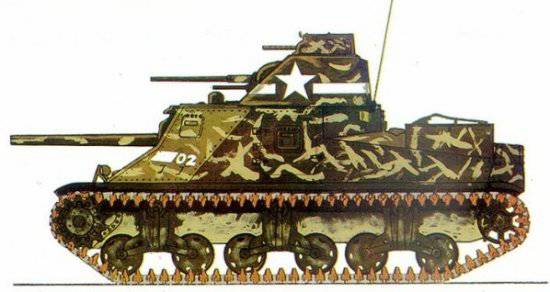
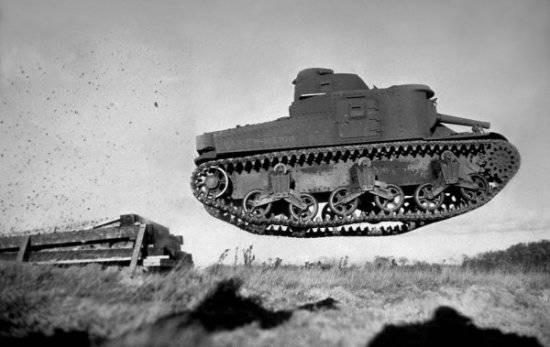
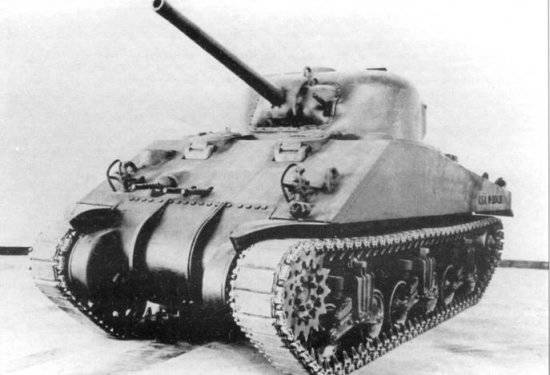
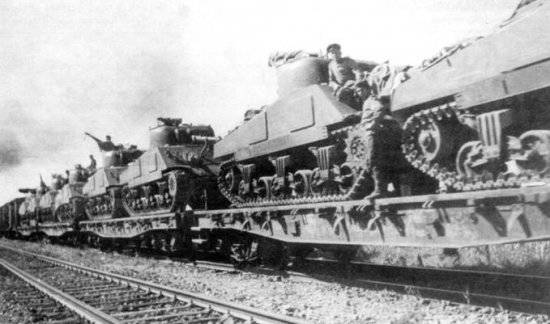
Information